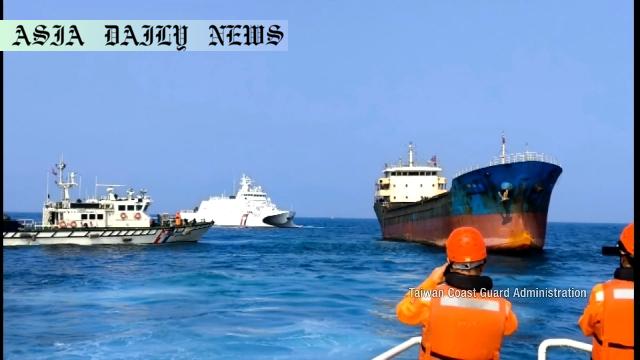Undersea Cable – Taiwan’s Coast Guard investigates the sabotage of undersea cables, hinting at possible gray zone activities by China.

Introduction: Rising Tensions in the Taiwan Strait
The recent disruption of undersea cables connecting Taiwan to the Penghu Islands has raised fresh concerns regarding maritime security and geopolitical tensions. Taiwan’s Coast Guard suspects the involvement of a cargo ship with a Chinese crew, highlighting what it calls ‘gray zone’ activities. This incident, coming shortly after another similar disruption last month, puts the spotlight on increasing subversive actions in the region, executed with strategic vagueness to avoid a direct military conflict.
The Incident: Uncovering the Disruption
The undersea cable was reportedly damaged between Saturday and Tuesday early morning, prompting a swift response from Taiwan’s Coast Guard Administration. The disruption was flagged by a Taiwanese telecom operator, leading to the discovery of a cargo ship, anchored near the affected area. The vessel, registered under Togo’s flag, had its eight crew members detained for questioning. Notably, all crew members onboard hailed from China, further intensifying suspicion.
Understanding Gray Zone Activities
Gray zone activities refer to actions that fall between overt diplomacy or conflict and direct military aggression. These subtle yet impactful strategies often create geopolitical tension without breaching conventional thresholds of war. In this case, Taiwan authorities are urging deeper investigations to determine whether the damage was accidental or intentional. While the definitive cause is uncertain, the ship’s Chinese affiliations have fueled speculation of state-influenced activities circumventing direct accountability.
Implications for Regional Security
Given that the Taiwan Strait is a significant passage in global geopolitics, incidents like these have broader implications. Taiwan relies on these undersea cables for critical communication infrastructure. Accidental or intentional disruptions highlight vulnerabilities in maritime security, which could escalate tensions not only with China but also with other regional stakeholders. This increases the urgency for Taiwan to strengthen its undersea protection systems and seek international support for ensuring stability in the strait.
Second Incident in Two Months: A Pattern Emerges
This latest damage follows a similar incident last month, also blamed on a cargo ship with a Chinese crew. The recurrence of such disruptions raises alarms about a developing pattern. Additionally, experts highlight that such repeated activities can gradually impair Taiwan’s readiness and strategic response. The cost of repairs, the implications for telecom reliability, and the attendant political connotations add to the challenges faced by Taiwan in countering these potential threats.
Geopolitical Repercussions
These incidents occur against the backdrop of strained relations between China and Taiwan. Although gray zone tactics fall short of formal aggression, they underscore escalating strategies to undermine Taiwan’s security and resilience. Given Taiwan’s strategic importance in Asia, other nations might weigh in to condemn these activities. It further underscores the necessity of clear international regulations to prevent deliberate sabotage of global communication infrastructure.
Conclusion: Navigating an Uncertain Future
This situation serves as a reminder of the increasing complexities in Taiwan-China relations. The ambiguity and attribution challenges of gray zone activities make them difficult to counter effectively. Taiwan must bolster its investigative capabilities, maritime surveillance systems, and foster international collaboration to address these emerging challenges. This will involve not only securing its telecom infrastructure but also ensuring sovereignty in an increasingly contested maritime domain.
Commentary
The Growing Challenge of Protecting Undersea Infrastructure
The disruption of undersea cables in the Taiwan Strait showcases a concerning pattern of emerging subversion tactics. As global connectivity continues to rely heavily on undersea communication lines, safeguarding these vital infrastructures is of paramount importance. The difficulty in attributing damage—whether accidental or deliberate—makes such incidents uniquely challenging. The sheer strategic ambiguity of these gray zone operations highlights their effectiveness in creating uncertainty while avoiding direct accountability.
Implications Beyond Taiwan
This issue is not confined to Taiwan’s borders. The broader implications of such actions extend to nations around the globe that rely on uninterrupted underwater communication networks for economic and strategic operations. If gray zone tactics are left unchecked, other global players may face similar vulnerabilities. This underscores the need for international action in establishing codes of conduct to protect undersea infrastructure and sternly respond to deliberate disruptions.
Proactive Measures Are the Need of the Hour
In light of this incident, Taiwan must continue to develop its maritime and technological capabilities. Enhanced surveillance systems, early warning mechanisms, and robust investigation protocols can strengthen resilience. Furthermore, deeper collaboration with allies and international organizations can ensure better preventive measures against these threats. Solidarity in addressing these incidents will be critical in mitigating their long-term impacts.


